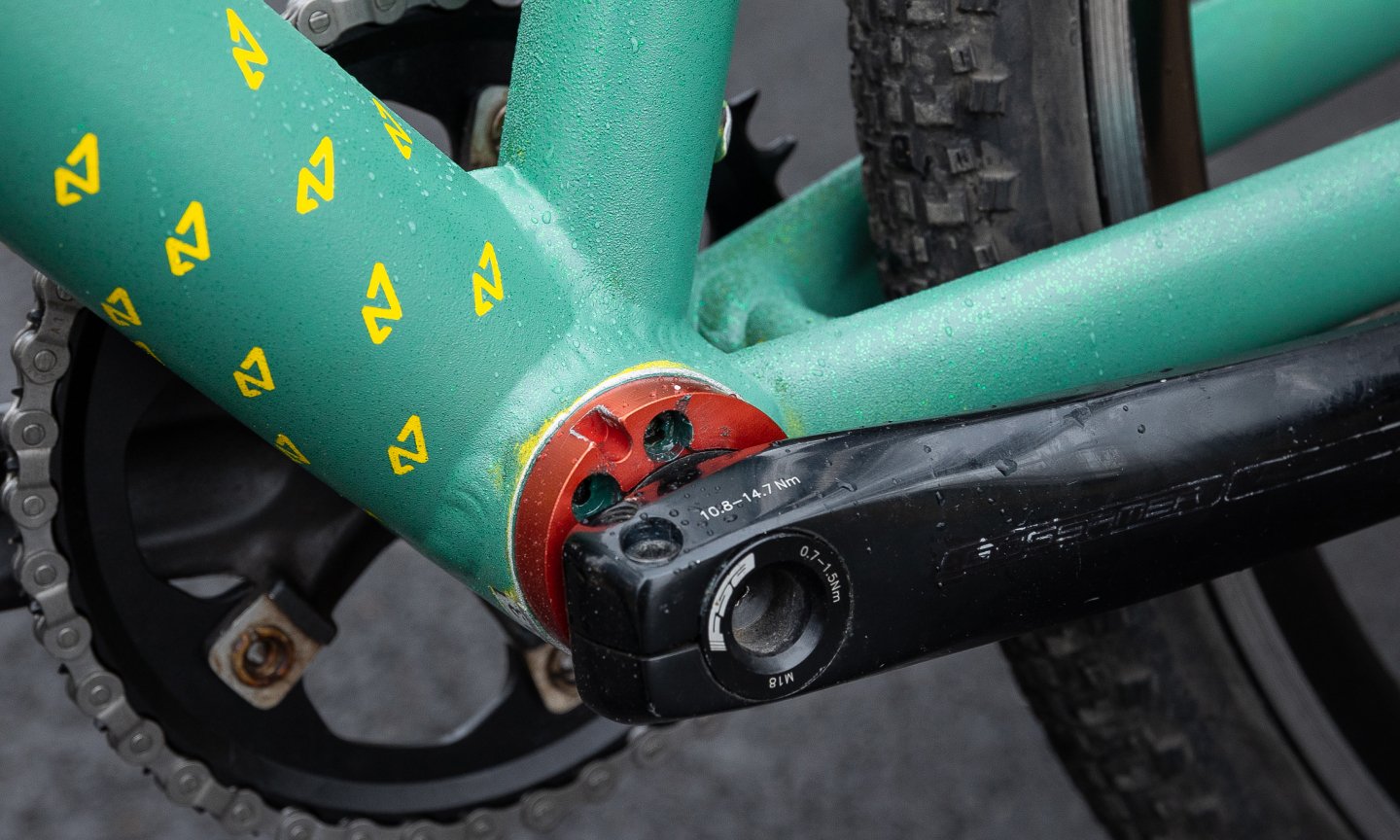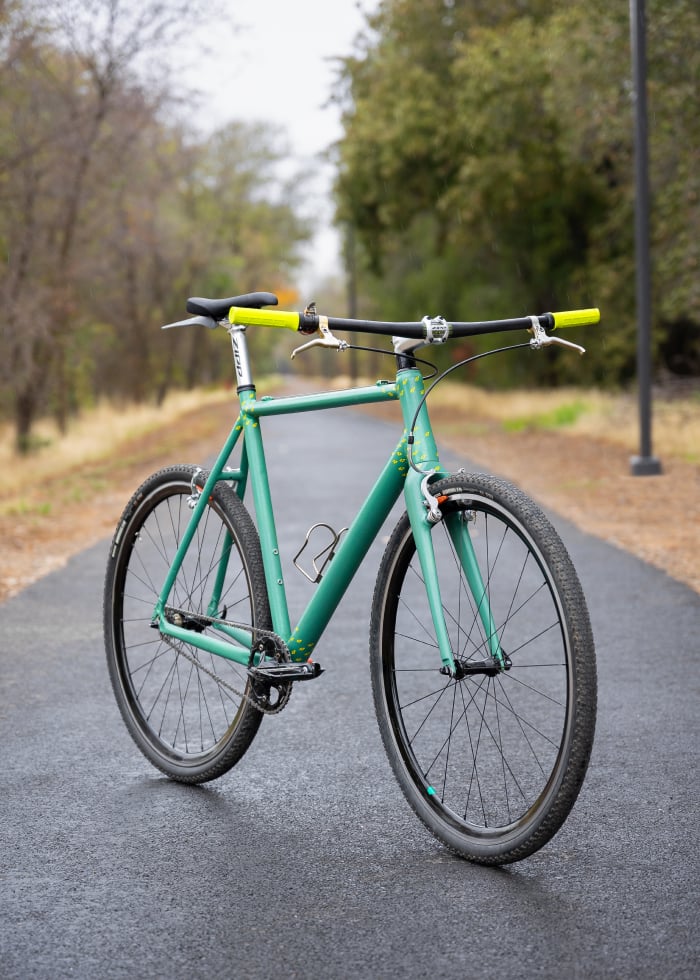If you haven’t noticed, bikes and bike parts have been hard to come by lately. We’re not
here to tell you why as we’re sure you’d heard all the fun supply chain details at this point. But if
you’ve been drooling over a new gravel bike and are frustrated that it seems impossible to get a
complete bike or even the parts to build one, we have a proposition – have you considered building a
single speed?
We know, we know – Why in the world would any sane person want a single gear bike? Isn’t that why the
derailleur was invented in the first place? You wouldn’t be wrong to ask those questions. But hear us
out – is there a bike in your possession that just doesn’t get a lot of ride time anymore? Maybe it
needs a second life or a bit of a refresh? Perhaps you’ve always wanted to try cyclocross, but never
wanted to invest in a bike to see if you even like it? Maybe you’ve been thinking of commuting but never
want to do it on your “nice bike?” A single speed is the tool for all of these jobs!
// WHY CONSIDER A SINGLE SPEED GRAVEL OR CYCLOCROSS BUILD DURING
COVID?
Modern drivetrains have gotten incredibly proprietary. They are often designed to
work as “system” and the components aren’t interchange with other manufactures components. This
compounds the issue of limited availability as alternative parts and components to the ones you
want may not exist. For example, let’s say you are able to source everything you need for a
gravel build, save for a chain. Pending the group you select, it may require a specific chain.
If you can’t get a hold of that chain, you are out of luck. Single speed drivetrains are simpler
and there are more alternative and substitute parts out there, increasing your odds of finding
parts to complete a build.
Single speeds are light – less stuff hanging from the bike means less weight. Single speeds are simple and low maintenance – gravel and CX riding means dirty and sometimes muddy conditions. These conditions wear on drivetrains, degrade shifting performance and requires lots of cleaning to keep a bike running smoothly. With a single speed, there is less complexity and less moving parts.Simple also means less to break – Salsa developed the “Storm Chaser,” a dedicated gravel single speed bike, after watching the chaos of a wet course at the Mid-South Gravel race. The mud became such a sticky issue that many participants abandoned the race due equipment failures. Many were stuck in one gear position. Others had derailleurs ripped off their frame entirely.Singles speed riders automatically get extra points for being tough.// WHAT TO LOOK FOR IN A FRAME TO BUILD A SINGLE SPEED
The biggest issue that must be addressed with a single speed is keeping the chain tensioned. On geared bikes, the rear derailleur is responsible for this duty. When you don’t have a rear derailleur, snugging up that chain can be done a few ways:
Horizontal drop-outs – a frame with horizontal drop-outs allows moving the wheel forward and backward to set chain tension. This is not common on modern bikes, but you might find a retro mtb frame that would work for this.Eccentric Bottom Bracket – an eccentric bottom bracket basically means that the opening for your crank spindle to pass through is off center. By placing it off-center, you can rotate the bottom bracket which effectively moves the crank further or closer to the rear wheel to adjust chain tension. This method works great on many frames produced in the last 10 years or so. If you can find a frame with press fit style bottom bracket, specifically a PF30 of BB30, eccentric might be a good solution.Chain Tensioner – this is the most universal method to convert a bike to a single speed. A chain tensioner mounts from the derailleur hanger. The chain passes through it like a derailleur and it can be adjusted to add or remove tension from the chain.
// WHY USE A FLAT HANDLEBAR ON A SINGLE SPEED?
Leverage – Without gears, you will likely have to do a lot of standing to get up hills and climbs. The wide hand position of a flat bar is great for leverage.Comfort – even those of use that spend most of our time on road bikes recognize that a road drop bar can be uncomfortable. Its designed to get you into a lower position, which may not be critical on a mellow commute. A wide, stable upright position feels better if you have a backpack on. It might not be the choice for a 3 hour+ ride on pavement, but for a shorter commute, it can be nice.Flat bar brake levers are common and tend to be less expensive than drop bar brake levers. The pull of the lever also matches up well to more v-brakes.
// WHY ARE GRAVEL/CX BIKES GREAT COMMUTERS?
Most of our commutes and grocery runs (or emergency trips to the brewery when the fridge is getting low) are paved. So why would you need a gravel bike?
Wider tire clearance – wider tires are just more comfy. And let’s be honest, paved roads have less than perfect asphalt. Maybe you want to squeeze every last watt out of your road bike on your training rides, but that setup is not comfortable for day to day commuting use. Trading some speed for comfort on your commute is a tradeoff many are willing to make. On the other side of this is your mountain bike. These are just not that run to ride on paved surfaces, especially if you have a full suspension bike. MTB suspension has come a long way in improved efficiency and reduced weight, but it’s just not the same as a fully rigid frame. If your place of work has stair or an elevator, mountain bikes are bigger, heavier and often dirty.
Wider tires might also be better in adverse weather – pending the tire you use, they could be better in the rain or off season when roads tend to have more debris on them, making a safer and more reliable commute. Wider tires = higher air volume and lower air pressure and usually don’t need to be pumped up as often this is especially nice for daily commuting.Fenders and racks – some gravel and cx bikes have dedicated mounting points for fenders and racks. If they don’t, they at least have tire clearance that is more likely to fit a range of clip-on style fenders than your road bike or the limitations of created by the suspension on your mountain bike.// WHAT IF I LIVE IN A HILLY OR MOUNTAINOUS AREA?
Admittedly, single speeds can make riding in these kinds of terrain extra challenging. But, that’s some of the fun of it. Messing with gear ratios to match up to the course of the day is an art and a science that can be a lot of fun. Under gear your bike and you’ll have the advantage in accelerations out of turns, getting up to speed and climbs. Over gear it and you’ll have more gear to use on sustained power sections, downhills and sprints. A single speed can teach you how to spin a higher cadence and how to power down with a low cadence.
// PRACTICAL APPLICATION
Considering all of this, our general manager, Ryan, was ready to enjoy some fall riding in the foothills and was having trouble sourcing a bike. He decided to go through the exercise of building a single speed to show everyone what could be done.
// THE BUILD:
Ryan cheated a bit as he had already done most of what you find in this article to build a bike he used to park on college campus. This was a 2004 Blue Norcross Cyclocross bike. At the time, to reduce the risk of theft, he’d spray painted it black and converted it to a single speed with some components from his parts bin. To make this a viable gravel rig, he wanted some more stopping power and was looking to go to a v-brake. He also wanted a wider bar and was going to adjust the fit to suit longer miles.
Now that the bike was looking fresh, it was time to throw together a bike. Some parts came from the parts bin, some from buddies, other were purchased from what was available.
This not only made for a fun project, but it has become one of Ryan’s favorite bikes to ride. There’s something about a simple bike – no batteries to recharge, no derailleurs to adjust, no apps or complex set-up procedures, no brakes to bleed. The bike goes and it stops. Its nimble and playful and makes a commute in town fun. Single speeding makes the bike feel like an extension of the rider. You’re somehow more connected to the machine.
It may not be for everyone, but it might be for you. If you’re in the marketing for a gravel or cyclocross bike, consider building a single speed.
As always, if you have any questions with your build, feel free to reach out so we can help!






